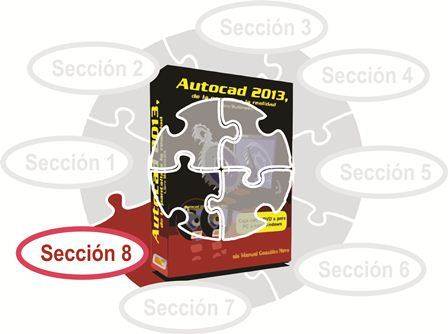3D Drawing with AutoCAD - Section 8

35.2 ViewCube
An 3D navigation tool similar to Orbita is ViewCube. By default you will see it activated in the workspace, but if it is not, it is activated in the brow Browser, in the Windows section with the User Interface button. It is a cube that, also by default, is in the upper right corner of the work area, although we can change it, which not only offers the flexibility of viewing Orbita 3D models, but also shows the orientation Cardinal of the model based on the SCU (Universal Coordinate System) or some SCP in use.
We can click on any of the faces of ViewCube, its edges or in its vertices and that will be the view that acquires the model. Obviously we can also drag it freely with the mouse, just like we did with Orbita. If no object is selected, clicking on the cube will automatically apply an extension zoom. If, on the other hand, there is an object selected, then the cube will move without zooming and framing on that object.
Thanks to the fact that the faces are labeled and the cube mounted on a compass, you will always know the orientation of the model with respect to the SCP in use.
ViewCube also has a contextual menu that allows you to change the projection of the model between Perspective and Parallel (which we saw in the previous section), as well as allows us to define any of its views as the start view. Below ViewCube you will see a list of saved SCPs (if they exist), to load them, with which ViewCube will use them as a reference. Finally, from this context menu you can open the dialog box with which we configure its behavior.
35.3 SteeringWheel
SteeringWheel or Navigation Wheel is a tool that condenses several other navigation tools 2D and 3D that we have already studied adhering them to the cursor. We can activate it from the Browse section of the View tab or from the navigation bar that we can have in the drawing area. It has several versions, but obviously using the full version allows us to later use any of them without any problem.
To use any of your options, simply click with the mouse and, without releasing the right button, manipulate the drawing to move on it. The Rewind function is particularly interesting because it generates a history of changes in the drawing display so that we can easily return to some previous point through small preliminary views of those points. But let's see how to use SteeringWheel to run a model.
We said that this wheel has other versions of it, whether in miniature, simplified versions or both, although it is the same navigation tools. To select another version of the wheel we use the contextual menu of the wheel itself.
Like the ViewCube, SteeringWheel has a dialog box to configure its behavior. This box can be opened from its context menu or from the options button.

